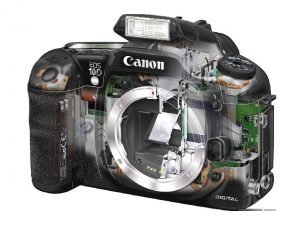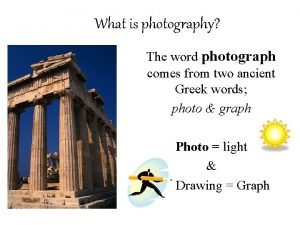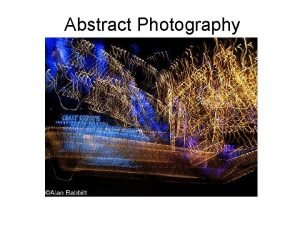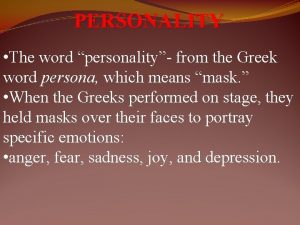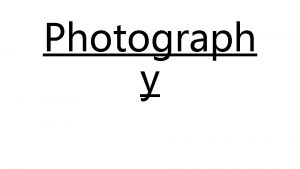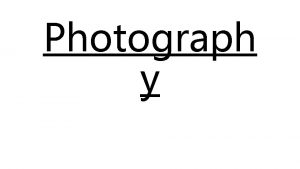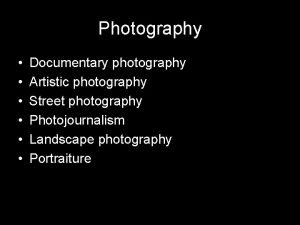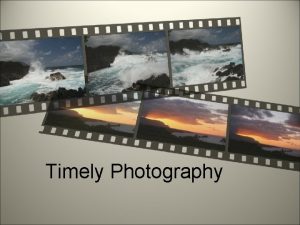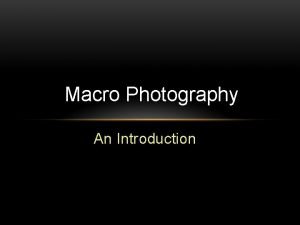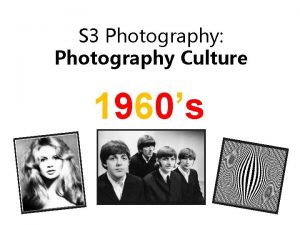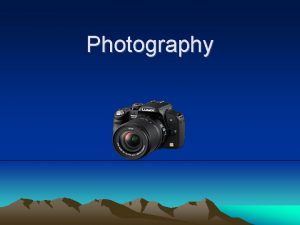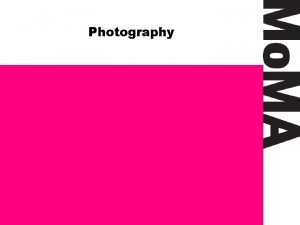What is photography The word photograph comes from






















- Slides: 22

What is photography? The word photograph comes from two ancient Greek words; photo & graph Photo = light & Drawing = Graph

Physics lesson for the day Light travels in a straight line. When light rays hit a subject, they are reflected. When reflected through a small hole of thin material, (the aperture), the rays do not scatter, they simply cross.


The Camera obscura (1 st Camera) When reflected onto a flat surface, (surface must be parallel from aperture), in a darkroom the subject will appear upside down. http: //www. paleo-camera. com/camerapage. htm

In the beginning …. . The Camera Obscura (Latin for “dark room”) • MO- Ti Chinese philosopher -earliest mention 5 th century BC • Aristotle Greek Philosopher– 384 -322 BC • Alhazen Islamic scholar and scientist- 965 -1039 • Leonardo Da Vinci Italian polymath- 1490 • 17 th century- many famous artists begin using camera obscura as a drawing tool (Vermeer, Canaletto, Guardi) http: //www. vermeerscamera. co. uk/room 7. htm http: //brightbytes. com/cosite/portable_plans. html

Still existing today. . . and attracting a crowd The camera obscura in Santa Monica, CA Thank You Jack & Beverly Wilgus (for sharing your vacation pictures and website!) http: //brightbytes. com/cosite/portable_plans. html



The Lens • curved piece of glass or plastic. • Its job is to take the beams of light bouncing off of an object and redirect them so they come together to form a real image



FILM The Photographer’s Canvas Just like an artist applying paint to a canvas, the photographer introduces light to film to make a picture. A good photographer is a kind of artist and, like the painter, must understand the fundamentals of his or her tools and materials, including film, in order to make better pictures.

FILM The media used to record information (or light) in a camera • Essentially, when you expose film to a real image, it makes a chemical record of the pattern of light. • It does this with a collection of tiny light-sensitive grains, spread out in a chemical suspension on a strip of plastic. When exposed to light, the grains undergo a chemical reaction

*The structure of film and photo paper are similar, both start with a base material -plastic or paper. EMULSION: layer made up of silver nitrate or sliver halide suspended in a gelatin base. • The silver salts that record the image are formed in crystals or grains which react to the light hitting them. F. Y. I …Silver-halide grains are made by combining silver-nitrate and halide salts (chloride, bromide and iodide).

PINHOLE CAMERAS • A pinhole camera is the simplest camera possible. • It consists of a light-proof box, some sort of film and a pinhole. • The pinhole is simply an extremely small hole • . A pinhole camera is simply a smaller version of that room • . The film records the image that comes in through the pinhole.


Stop!

• camera obscura, Latin for "dark room. " • The camera obscura was actually invented hundreds of years before photography. • A traditional camera obscura was a dark room with light shining through a lens or tiny hole in the wall. • Light passed through the hole, forming an upside-down real image on the opposite wall. • This effect was very popular with artists, scientists and curious spectators.

• Imagine that outside the room is a friend with a flashlight, and he is shining the flashlight at different angles through the pinhole. When you look at the wall opposite the pinhole, what you will see is a small dot created by the flashlight's beam shining through the pinhole. The small dot will move as your friend moves his flashlight. • The smaller the pinhole (within limits), the smaller and sharper the point of light that the flashlight creates. http: //users. rcn. com/stewoody/



 Photography from the greek word “photos” meaning
Photography from the greek word “photos” meaning Photography greek word
Photography greek word Photos and graphos meaning
Photos and graphos meaning The word photography is greek for
The word photography is greek for Photography comes from the greek words photo and graph
Photography comes from the greek words photo and graph Is abstract photography same as conceptual photography
Is abstract photography same as conceptual photography Parts of a greek temple
Parts of a greek temple Computer comes from
Computer comes from The word tessellation comes from the root word
The word tessellation comes from the root word Where does the word advent come from
Where does the word advent come from What is the structure of an italian sonnet?
What is the structure of an italian sonnet? Revelation comes from the latin word
Revelation comes from the latin word Word physics is derived from
Word physics is derived from The word personality comes from the greek word __________
The word personality comes from the greek word __________ What is polygon in maths
What is polygon in maths The columns at the parthenon follow the ________ order.
The columns at the parthenon follow the ________ order. The term photography literally translates to
The term photography literally translates to First comes love then comes marriage
First comes love then comes marriage Latin word for sea creature
Latin word for sea creature Where does the word volcano come from?
Where does the word volcano come from? Topology comes from the greek word topos which means
Topology comes from the greek word topos which means Where the word psychology does come from?
Where the word psychology does come from? What comes into your mind when you hear the world
What comes into your mind when you hear the world
